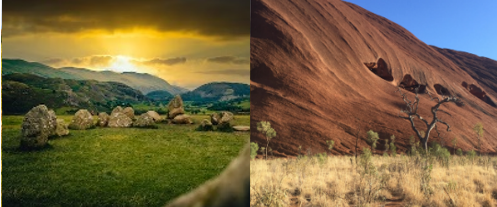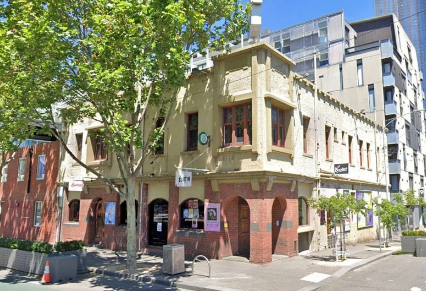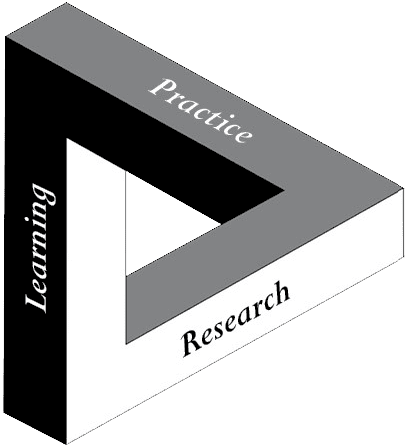(#7 in the ‘Sense of Place’ series)
In this week’s article, I share elements of my own story of the relationships I have formed with some of the places and spaces that I have passed through — and that have shaped me —since I was born. With an estimated 100 billion human lives lived since we emerged as a species[1], my story is just one of around 100 billion stories that have contributed to the human notion of ‘sense of place’. And my story is just one of 7.9 billion stories being created by humans alive today[2].
Globally, the Anthropocene is dramatically altering the character of the places that we have inherited from our ancestors. Solastalgia, ‘the homesickness you have when you are still at home’[3], is emerging as a major threat to mental health[4]. First Nations peoples are only too familiar with this longing for ancestral places that have been changed outside of their control.
Introduction
Throughout our evolution, we humans have developed highly refined ways of adapting to new environments and identifying the aspects of each environment that afford us the maximum degree of survival. Human cognition probably evolved before language, and thus the perception and cognition of visual and spatial information has played a central role in human evolution and remain central to human thought[5]. Therefore, environmental preference is not a frivolous human preoccupation, but, along with the notion of aesthetics, is closely tied to our evolutionary survival[6].
As environmental psychologists such as Rachel and Stephen Kaplan have long demonstrated, humans have a strong drive to ‘make sense’ of (interpret) our environment and to be involved with it. We prefer environments that afford us safety, food and shelter. We are also motivated to locate environments where our curiosity will be stimulated, whilst at the same time affording a degree of certainty.[7]
Environments that ‘make sense’ afford a degree of coherence, with the individual parts combining to form a harmonious whole. [8] We favour environments that offer a combination of texture, spaciousness, identifiability, coherence, complexity and mystery.[9]
Using Maslow’s ‘hierarchy of needs’ as a touchstone, we seek encounters with places and people that enable us to experience belonging, fellowship, intimacy, competence, self-actualisation and transcendence[10]. Our choices may be influenced by individual characteristics and experiences, as well as subliminal sociocultural factors. [11]
Some anecdotes from my own experiences of place
The notion of ‘place’ has long been important to me. I’m the product of a British landscape architect and schoolteacher. They had met whilst living in Kuwait, and I grew up surrounded by artefacts, stories and images of Kuwait, Isfahan and Pakistan. In 1967, my parents left behind the Neolithic stone circles, ancient ley lines, Roman ruins, and Nordic remnants of their ancestral lands and brought four-year-old me and my two siblings to Australia. That’s the year that white Australian society voted at a referendum to include Indigenous peoples as part of the human population of the continent (rather than being classified as flora or fauna). As favoured white people, it cost my family £10 to come here.

The Fairsky, September-October 1967
In 1970 as new migrants to Perth, my parents bought a caravan, and we joined the WA Caravan Club. I spent my seventh birthday on a caravan ‘rally’ to the WA goldfields. On a similar group excursion to the interior, my 13-year-old sister befriended a young Aboriginal girl who lived in a rudimentary tin shack behind the caravan park at Menzies. Years later, she and her family came to visit us at our suburban home. I remember feeling a sense of bemusement at this most gracious of visits by this most gracious of Traditional Owners – who was on her way to complete a nursing qualification. We certainly had no idea that this young woman was part of the Wongi or Wongatha/Wangkatha language peoples. Nor did our entirely Anglo caravan club elders ever reflect on how none of the country through which our convoy traipsed had ever been ceded to colonial arrivals.
These childhood experiences were incredibly evocative and formative for me, and I developed a deep sense of awe and reverence for this huge continent. I always felt that I belonged. However, I also had to make sense of my own memories (real and imagined) of my own ancestral lands.
After years of wistfully watching the weekly Qantas 747 fly over our house on its way to London, I finally returned to the UK as a 19-year-old. There, I hiked along Hadrian’s Wall, traipsed through Scottish farmland to find ancient stone circles, and visited elderly relatives who still lived in the midlands of England where our 13th Century ancestor, Henry de Butterworth, had owned land. I hitchhiked across the Continent and ended up working as a farm hand on the Peloponnese, not far from the site of the first Olympics. No doubt, throughout all this questing, I covered terrain trodden by my Anglo, Celtic, Scandinavian and Roman ancestors.
Back in Perth after 14 months away, I seized an opportunity to study environmental and community psychology, during which my research interest in ‘place’ was spawned. Then followed several years of community development practice in the Northern Territory and New South Wales.
In the early 90s I lived in Darwin, where I helped to establish community-based HIV support services. Here, I encountered many people who had fled there from the south in the hope that they might leave behind their life complications and perhaps even biographies that had become enmeshed with other places. Some, seeing no way out in those days before medicine could offer a lifeline, elected to end their lives there, and thus any relationship with place at all. Meanwhile the Larrakia, Arrernte or any of the other 40 or so indigenous nations across the Northern Territory led culturally creative and resilient responses to HIV and AIDS that maintained their individual and collective place identity, attachment, dignity, and custodianship.
Later in NSW, I supported people who had experienced brain injury and encountered many young people, surviving road trauma in the prime of their lives, whose injuries that left them profoundly different from their old selves. Limited social support, accessible services, public transport, or an enabling urban form meant that survivors usually had no option but to move back to a family home that they had previously outgrown. The family home became a psychological prison both for them and their family caregivers, further complicating their recovery. The other accommodation options tended to be institutional aged care facilities or penitentiaries— where evidence of acquired brain injury is widespread. These people were experiencing place dependence — needing to be somewhere to receive or provide basic care because it couldn’t be found elsewhere — but certainly not place identity. They certainly did not identify their sense of self with that place – in fact, it is likely that they saw themselves as being the opposite of where and how they now found themselves: “I would rather live somewhere else. This one is not the place for me” [12].
In 1996 I moved to Melbourne to commence my PhD. I immediately felt at ‘home’. There was an intimacy engendered by Melbourne’s urban form that I’d never experienced elsewhere in Australia. Here, I developed and led a series of adult education programs designed to support local people to learn how to channel their latent environmental concerns into collective action. I based one of my programs in my own neighbourhood, St Kilda.

From my recruitment brochure
The participants who joined my local action research and training program were older members of the St Kilda Historical Society, who worried about the loss of urban heritage in their neighbourhoods. For them, the loss of urban heritage was an environmental issue. They engaged in my program to learn more about ways of communicating about, and advocating for, the need to preserve local landmarks. Their environmental action was inextricably linked to preserving the relationship between their local places and their own sense of identity. They fully understood that places didn’t need to be architectural marvels to be protected – they just needed to be loved and acknowledged as intrinsic to the local history and culture of a place, and the biographies of those who lived there. In other words, these places contribute to ‘sense of place’. (I will forever associate the St Kilda library with the session that I ran with the Historical Society on the day that Princess Diana died, on my birthday, in August 1997).
One of my favourite St Kilda haunts was the Greyhound Hotel. This raffish, art-deco pile had served as a community meeting place for local LGBTI residents and other locals for almost 100 years. As a youngster, Don Taggard, the President of the St Kilda Historical Society, had helped his father run the local dairy near marshland adjoining the Greyhound. At night, Don would traverse the marshland behind the Greyhound Hotel on gangplanks lit by kerosene lanterns. Don still lived in the house in which he had been born 70 years earlier. For me, the hotel and nearby St Kilda Town Hall, each on opposite sides of Brighton Road, served as a symbolic gateway to my local neighbourhood. (As the Number 3 Tram turned east into Carlisle Street from Brighton Road, I felt that I had come home.) The Greyhound was part of the local community fabric. The building certainly wasn’t fancy, but it was quirky. It was integral to the character of the local neighbourhood, and to people’s individual and collective stories.

Then: The Greyhound Hotel. Image credit: Wade, M, 2017, The Greyhound Hotel, Image:Instagram, https://www.starobserver.com.au/news/national-news/victoria-news/report-greyhound-hotel-saved/157592
Despite its significance, local heritage laws did not protect the Greyhound Hotel from destruction in 2017 by the international hedge fund that had bought it. My understanding is that the local Council’s heritage assessment did not deem it to be ‘pretty’ enough. Locals mourned its destruction and took home bricks as mementos. Were he still alive, Don probably would have been heartbroken. Several years following the hotel’s destruction, the site remains an empty scar. For several years following demolition, I couldn’t bring myself to go near it.

Now: Image credit: Carbines, S, 2019, The Greyhound Hotel, St Kilda site is for sale again, https://www.realestate.com.au/news/greyhound-hotel-st-kilda-what-will-be-built-on-development-site/.
These potted examples of my own temporary, non-lethal — and, let’s face it, privileged — losses of place invariably make me think of the complex and painful relationship that Traditional Owners must experience with places that have been changed outside of their control. At an even deeper level, I try to imagine the ongoing psychological trauma to Aboriginal people’s own personal and collective identity of being forcibly removed from place and Country under the unresolved colonial lie of terra nullius. “Indigenous people are like long-term refugees displaced on their own land. Nothing has changed and nothing has been done about it.”
In my next posting, I will discuss my attempts to understand the interface been colonial and Indigenous conceptions of place.
References
[1] https://en.wikipedia.org/wiki/Estimates_of_historical_world_population
[2] https://www.worldometers.info/world-population/
[3] Albreccht, G. (2012) The age of solastalgia. The Conversation. https://theconversation.com/the-age-of-solastalgia-8337
[4] Albrecht, G., Sartore, G.-M., Connor, L., Higginbotham, N., Freeman, S., Kelly, B., … Pollard, G. (2007). Solastalgia: The Distress Caused by Environmental Change. Australasian Psychiatry, 15(1_suppl), S95–S98. https://doi.org/10.1080/10398560701701288
[5] Kaplan, S. & Kaplan, R. (1982). Introduction to Chapter 4. In S. Kaplan & R. Kaplan (Eds.). Humanscape: Environments for people (pp. 82-83). Ann Arbor, USA: Ulrich’s Books.
[6] Kaplan, S., & Kaplan, R. (1989). The visual environment: Public participation in design and planning. Journal of Social Issues, 45, 59-86. Quoted p. 65.
[7] Kaplan, S. & Kaplan, R. (1982). Introduction to Chapter 4. In S. Kaplan & R. Kaplan (Eds.). Humanscape: Environments for people (pp. 82-83). Ann Arbor, USA: Ulrich’s Books.
[8] Kaplan, S. & Kaplan, R. (1982). Introduction to Chapter 6. In S. Kaplan & R. Kaplan (Eds.). Humanscape: Environments for people (pp. 147-150). Ann Arbor, USA: Ulrich’s Books.
[9] Gifford, R. (1987). Environmental psychology: Principles and practices. Boston, USA: Allyn and Bacon, Inc.
[10] Maslow, A. H. (1987). Motivation and Personality. (3rd ed.). New York: Harper and Row.
[11] Kaplan, S. & Kaplan, R. (1982). Introduction to Chapter 6. In S. Kaplan & R. Kaplan (Eds.). Humanscape: Environments for people (pp. 147-150). Ann Arbor, USA: Ulrich’s Books.
[12] For more on this discussion, see Pretty, G. (2002). Young people’s development of the community-minded self. In A. T. Fisher, C. C. Sonn, & B. J. Bishop (Eds.), Psychological sense of community: Research, applications, and implications (pp. 183-203). New York: Kluwer Academic/Plenum Publishers. Quoted p. 192.




